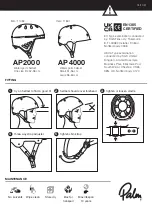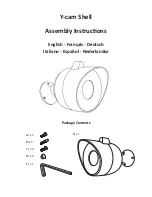
ELECTRIC VEHICLE MANAGEMENT SYSTEM V3
ZERO EMISSION VEHICLES AUSTRALIA
Current Sensor
The EVMS3 communicates with a current sensor on the CAN bus to receive instantaneous
current, and uses this to calculate battery State of Charge through integration over time. Two
types of current sensor are available, Hall Effect or Shunt.
Hall Effect current sensors are available for 300A, 600A or 1200A maximum, and
•
are installed simply by slipping the battery cable through the blue torus of the hall
sensor. Smaller rated sensors offer proportionally higher measurement accuracy so
are more appropriate for lower current systems. Hall sensors are normally easier to
install and generate no heat, but are a little more expensive and have slightly less
accurate zero point.
The Shunt Interface measures current flow through a shunt installed on the battery
•
cable and outputs it to the CAN bus. The Shunt Interface can work with 50A, 100A,
200A or 500A shunts, either 75mV or 50mV. Smaller shunts offer proportionately
higher measurement resolution. Note that the current ratings for the shunts are
maximum continuous ratings, but the shunt interface can measure up to twice the
shunt’s nominal rating intermittently - limited by heat buildup in the shunt. A shunt
interface plus shunt works out a little cheaper than the Hall Effect sensor and has a
slightly more accurate zero point (better accuracy with very low currents), but can
be a little more effort to install, and generates some heat.
As a general guide, hall effect sensors are more suitable for high power systems, and shunts
are more suitable for lower power systems.
In both cases the current sensor or shunt may be installed on either the positive or negative
battery wire. The Hall Sensor should be oriented such that discharge current flows from the
back (black) side to the front (blue) side. Ensure that there are no devices installed between
the battery and the current sensor or shunt, or the EVMS will not be able to calculate state of
charge correctly, since the current flow to/from those devices would not be measured by the
current sensor. Note: If the status light is blinking when no current is flowing, hold down the
button until it stops blinking to recalibrate the sensor’s zero point.
Charger Integration Options
To enable charging, the EVMS needs to switch into charging mode by connecting the Charge
Sense input to ground / chassis. This will wake it from sleep if needed, power up the CAN
bus to communicate with BMS modules, and start the charger. It will also prevent the vehicle
from being accidentally driven off while plugged in to charge. There are several ways to
implement charge detection:
A magnetic reed switch (or similar) can be wired between Charge Sense and
•
ground/chassis, and set up to close its contacts when the door/cover to the charging
port is opened.
An AC relay with its coil wired in parallel with the charger’s AC input, so that when-
•
ever the charger has power, the relay will also close to enable EVMS charge mode.
Some chargers (e.g newer TC Chargers) have an output 12V supply which can be
•
used to switch a small signal relay to join Charge Sense to ground / chassis.
It is also essential that the EVMS is able to switch off the charger if any cells exceed safe
voltage, to prevent damage from over-charging. There are several ways to implement this:
If using CAN integration with a TC Charger, the EVMS is able to disable the charger
•
over CAN bus so no additional control relays are required, and the Charge Enable
output can be left unused. To connect a TC Charger to a ZEVA CAN bus, join only
the CANGND, CANL and CANH pins. (The charger also has a 12V pin but this
should not be joined to the ZEVA CAN bus, since it is a 12V output, and only the
EVMS should manage 12V power to the CAN bus.)
Many chargers have a pair of control pins that get joined to enable the charger. To
•
use this mechanism, use a small 12V relay switched by the Charge Enable output of
the EVMS, with the normally open contacts wired to the enable pins.
The Auxiliary Contactor output is disabled as well as the Charge Enable output if
•
any cells go over-voltage, so if your traction circuit has any auxiliary contactors
(and your charger is tolerant of having its DC side interrupted mid-charging), there
is no need to add further relays/contactors to stop the charger, as the opening of the
auxiliary contactor will necessarily interrupt charge current.
The final option, which can be safely used with any charger, is to use a power relay
•
switched by the Charge Enable terminal from the EVMS, with the relay’s Normally
Open outputs wired to interrupt the AC input to the charger (as shown on the ex-
ample wiring diagram on the previous page).
Auxiliary Contactors
Auxiliary contactors (as shown on the example circuit diagram) are optional but can serve
several functions in an EV.
Split up high voltage battery packs into smaller groups of non-lethal voltage, or to
•
isolate separate groups of cells distributed around the vehicle, for safety.
Switch on/off other HV loads that are before the main contactor, either directly (us-
•
ing a relay switching power to the device itself) or indirectly (by breaking the main
traction circuit). The most common example is the DC/DC converter, so that it is not
permanently in-circuit.
Effectively functioning as an automatic maintenance switch. (If you don’t have an
•
auxiliary contactor breaking the traction circuit when the key is off, it is advisable
to have a manual maintenance switch to do the same job whenever working on the
vehicle.)
8
7




























